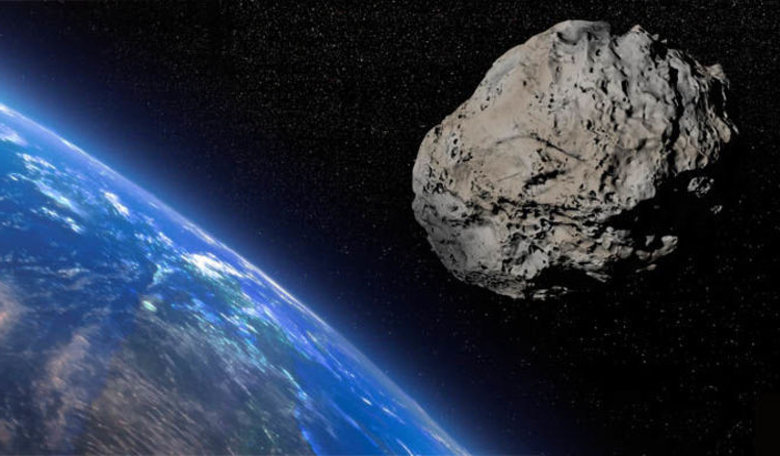Its a tricky time to be alive, not least because asteroid impacts are on the rise. Although the chances of being hit by one are still quite slim, according to a new study by researchers in the UK, the number of asteroids colliding with the Earth and Moon has increased by up to three times over the past 290 million years; a situation that was less than favourable with the dinosaurs.
Throughout Earth’s history, our planet and neighbouring Moon have been the subject of frequent asteroid strikes - many of which have been correlated with mass extinction events. In fact the Earth was pummelled so much in its early history, we even have a name for it; the Late Heavy Bombardment (LHB). This was thought to have occurred approximately 4.1 to 3.8 billion years ago.
Trying to establish how often asteroids have struck the Earth since then is very hard to work out and scientists have tried to understand the impact rate for decades. Usually they go about this by studying the craters left behind and dating the rocks left strewn around them and this generally works well.
However, when faced with a lack of craters from earlier epochs and given the dynamic nature of our planet, it led many to assume that the earliest craters had simply worn away over time due to erosion and other geological processes. Scientists then looked to the Moon as a proxy for what might have occurred on Earth, as it is likely that when one is hit, so was the other. And without plate tectonics and human activity to destroy the evidence of the impact, the Moon’s surface would be an almost perfect preservation record of how many strikes occurred in a given period.
This too though, is not as simple as it might sound, but a team at the Southwest Research Institute in Boulder, Colorado devised a way to date the lunar craters by studying the heat given off from the rocks that were cast aside in the impact. The thermal data and images were made available by the thermal radiometer instrument, known as Diviner, aboard NASA's Lunar Reconnaissance Orbiter (LRO).
Diviner showed the team that the surrounding, scattered rocks produced more heat compared with the fine lunar soil, and after calculating the rate at which Moon rocks break down into soil, a relationship between the amount of large rocks near a crater and the crater's age was revealed.
The team then applied this technique, which was developed by paper co-author Rebecca Ghent, a planetary scientist at the University of Toronto, to compile the ages of all lunar craters younger than about a billion years.
The result was very interesting. When the team compared the ages and numbers of craters on the Moon to those on Earth, they discovered that they are extremely similar. This questioned the long-held assumption that Earth had lost so many craters. "This means that the Earth has fewer older craters on its most stable regions not because of erosion, but because the impact rate was lower prior to 290 million years ago," said William Bottke, an asteroid expert at the Southwest Research Institute in Boulder, Colorado and a co-author of the paper.
The team’s result was supported by an unlikely geological feature on Earth - kimberlite pipes. Kimberlite is a rock made from cooling lava that can form in long vertical structures known as pipes. Kimberlite pipes are well known for containing diamonds and as such they are one of the most important sources of mined diamonds today.
Formed over the past 650 million years, their deep roots below the surface however are largely intact; indicating that large impact craters formed over the same period and in the same terrains should also be preserved.
Dr Thomas Gernon, Associate Professor in Earth Science at the University of Southampton, and co-author on the study, said: "Proving that fewer craters on Earth meant fewer impacts--rather than loss through erosion--posed a formidable challenge".
"It was a painstaking task, at first, to look through all of these data and map the craters out without knowing whether we would get anywhere or not," said Sara Mazrouei, the lead author of the paper who collected and analysed all the data for this project at the University of Toronto.
But the work paid off and it led to a result which suggests that the rate of crater formation over the last 290 million years has been two to three times higher than in the previous 700 million years. The reason for the increase is unclear, especially when one might assume that the Solar System appears to be less chaotic than hundreds of millions of years ago.
One suggestion is that large collisions taking place more than 290 million years ago in the main asteroid belt (between the orbits of Mars and Jupiter) created debris that has finally reached the inner planets causing rocks to rain down on us.
So, with an increase in asteroid strikes on the horizon, how does that bode for us humans, considering it it is widely accepted that they helped kill off the dinosaurs. “As a species we’re particularly vulnerable to large impacts from the get-go, more so than earlier animal groups", says Gernon. The outlook is not great then











